Paper Menu >>
Journal Menu >>
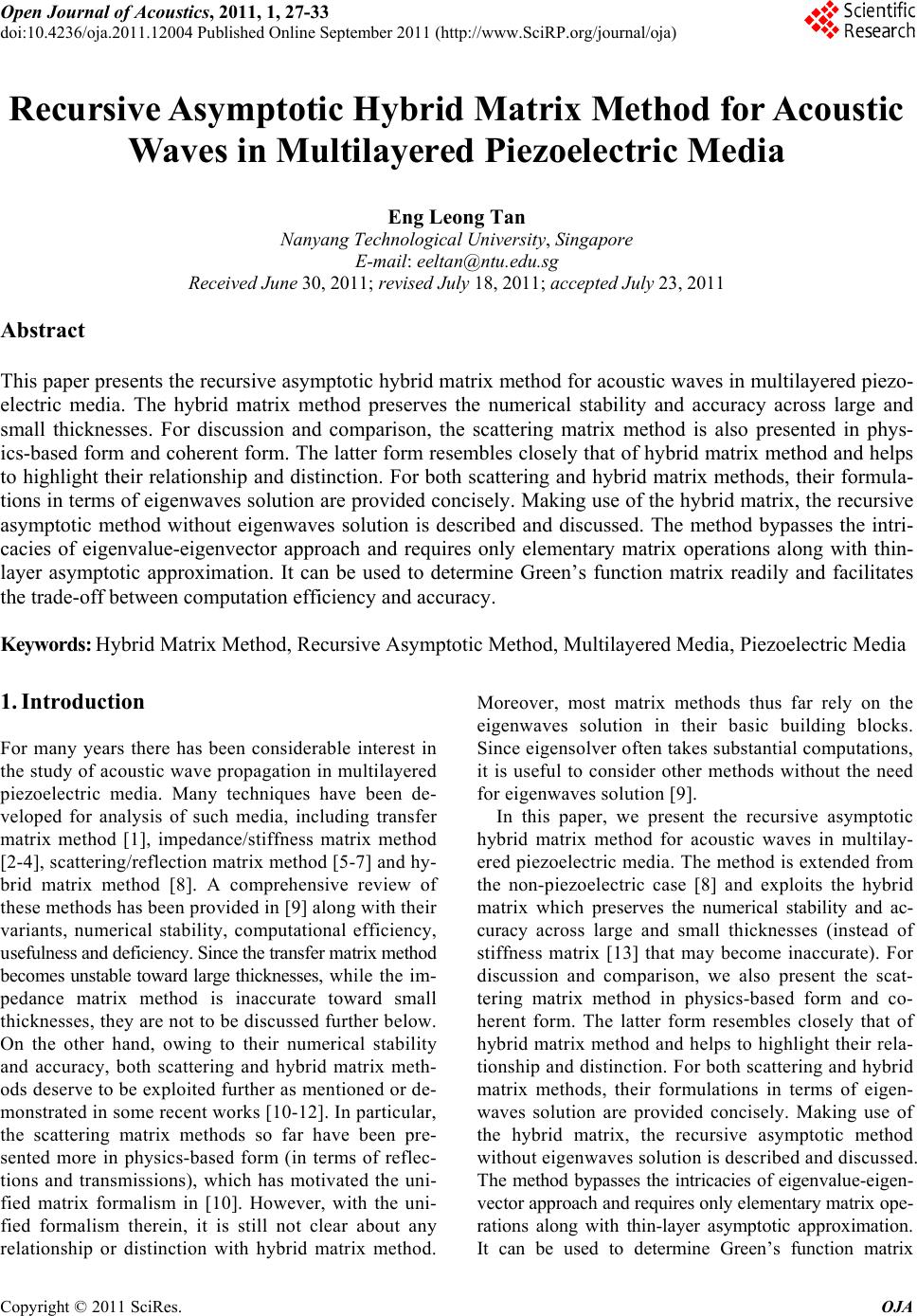 Open Journal of Acoust i c s , 2011, 1, 27-33 doi:10.4236/oja.2011.12004 Published Online September 2011 (http://www.SciRP.org/journal/oja) Copyright © 2011 SciRes. OJA Recursive Asymptotic Hybrid Matrix Method for Acoustic Waves in Multilayered Piezoelectric Media Eng Leong Tan Nanyang Technological University, Singapore E-mail: eeltan@ntu.edu.sg Received June 30, 2011; revised July 18, 2011; accepted July 23, 2011 Abstract This paper presents the recursive asymptotic hybrid matrix method for acoustic waves in multilayered piezo- electric media. The hybrid matrix method preserves the numerical stability and accuracy across large and small thicknesses. For discussion and comparison, the scattering matrix method is also presented in phys- ics-based form and coherent form. The latter form resembles closely that of hybrid matrix method and helps to highlight their relationship and distinction. For both scattering and hybrid matrix methods, their formula- tions in terms of eigenwaves solution are provided concisely. Making use of the hybrid matrix, the recursive asymptotic method without eigenwaves solution is described and discussed. The method bypasses the intri- cacies of eigenvalue-eigenvector approach and requires only elementary matrix operations along with thin- layer asymptotic approximation. It can be used to determine Green’s function matrix readily and facilitates the trade-off between computation efficiency and accuracy. Keywords: Hybrid Matrix Method, Recursive Asymptotic Method, Multilayered Media, Piezoelectric Media 1. Introduction For many years there has been considerable interest in the study of acoustic wave propagation in multilayered piezoelectric media. Many techniques have been de- veloped for analysis of such media, including transfer matrix method [1], impedance/stiffness matrix method [2-4], scattering/reflection matrix method [5-7] and hy- brid matrix method [8]. A comprehensive review of these methods has been provided in [9] along with their variants, numerical stability, computational efficiency, usefulness and deficiency. Since the transfer matrix method becomes unstable toward large thicknesses, while the im- pedance matrix method is inaccurate toward small thicknesses, they are not to be discussed further below. On the other hand, owing to their numerical stability and accuracy, both scattering and hybrid matrix meth- ods deserve to be exploited further as mentioned or de- monstrated in some recent works [10-12]. In particular, the scattering matrix methods so far have been pre- sented more in physics-based form (in terms of reflec- tions and transmissions), which has motivated the uni- fied matrix formalism in [10]. However, with the uni- fied formalism therein, it is still not clear about any relationship or distinction with hybrid matrix method. Moreover, most matrix methods thus far rely on the eigenwaves solution in their basic building blocks. Since eigensolver often takes substantial computations, it is useful to consider other methods without the need for eigenwaves solution [9]. In this paper, we present the recursive asymptotic hybrid matrix method for acoustic waves in multilay- ered piezoelectric media. The method is extended from the non-piezoelectric case [8] and exploits the hybrid matrix which preserves the numerical stability and ac- curacy across large and small thicknesses (instead of stiffness matrix [13] that may become inaccurate). For discussion and comparison, we also present the scat- tering matrix method in physics-based form and co- herent form. The latter form resembles closely that of hybrid matrix method and helps to highlight their rela- tionship and distinction. For both scattering and hybrid matrix methods, their formulations in terms of eigen- waves solution are provided concisely. Making use of the hybrid matrix, the recursive asymptotic method without eigenwaves solution is described and discussed. The method bypasses the intricacies of eigenvalue-eigen- vector approach and requires only elementary matrix ope- rations along with thin-layer asymptotic approximation. It can be used to determine Green’s function matrix 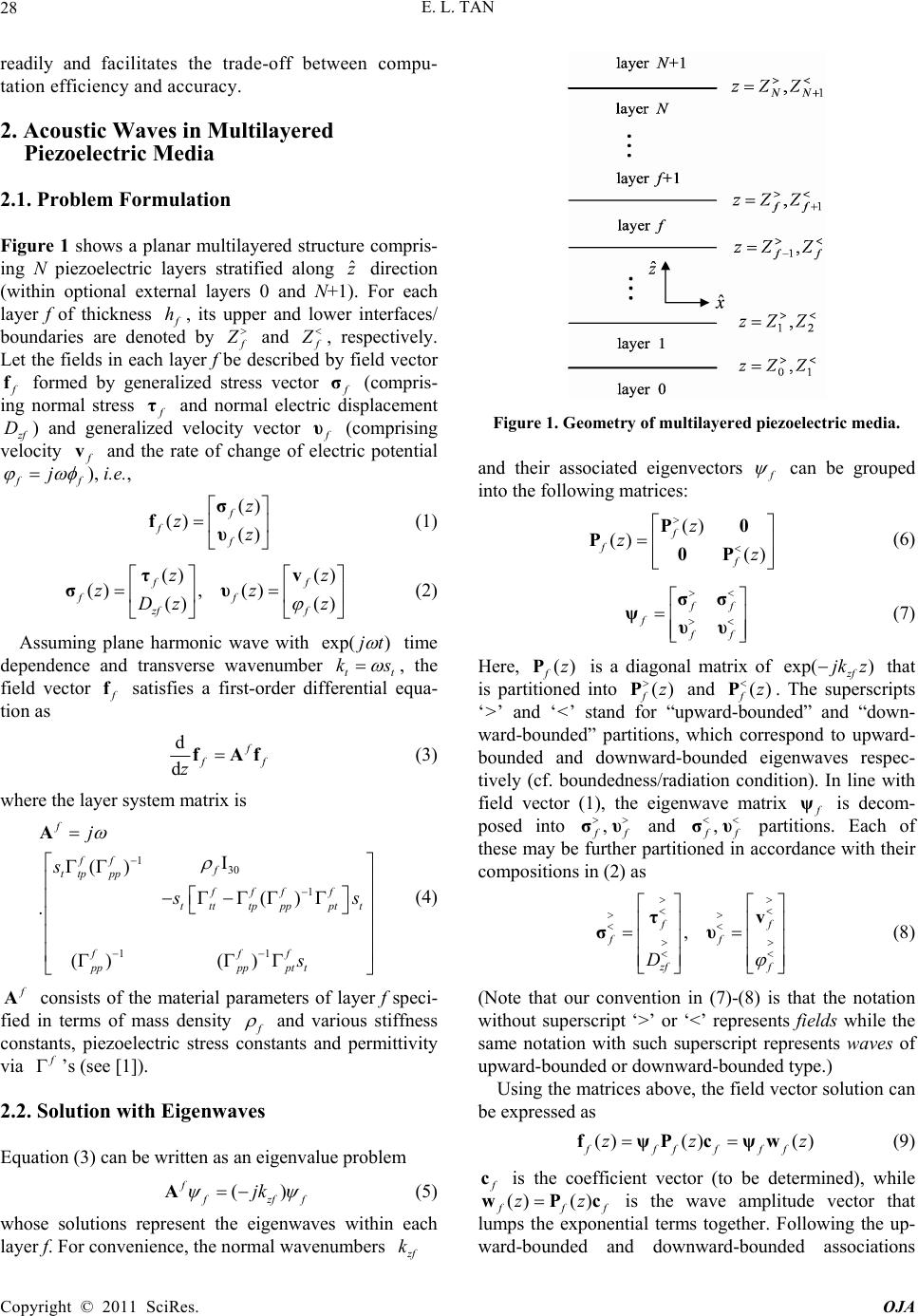 E. L. TAN Copyright © 2011 SciRes. OJA 28 readily and facilitates the trade-off between compu- tation efficiency and accuracy. 2. Acoustic Waves in Multilayered Piezoelectric Media 2.1. Problem Formulation Figure 1 shows a planar multilayered structure compris- ing N piezoelectric layers stratified along ˆ z direction (within optional external layers 0 and N+1). For each layer f of thickness f h, its upper and lower interfaces/ boundaries are denoted by f Z and f Z , respectively. Let the fields in each layer f be described by field vector f f formed by generalized stress vector f σ (compris- ing normal stress f τ and normal electric displacement z f D) and generalized velocity vector f υ (comprising velocity f v and the rate of change of electric potential f f j ), i.e., () () () f ff z zz σ fυ (1) () () (), () () () ff ff zf f zz zz Dz z τv συ (2) Assuming plane harmonic wave with exp( )jt time dependence and transverse wavenumber tt ks , the field vector f f satisfies a first-order differential equa- tion as d d f f f zfAf (3) where the layer system matrix is 130 1 11 I () () () () f ff f ttp pp fff f ttt tpppptt fff pppppt t j s s s s A (4) f A consists of the material parameters of layer f speci- fied in terms of mass density f and various stiffness constants, piezoelectric stress constants and permittivity via f ’s (see [1]). 2.2. Solution with Eigenwaves Equation (3) can be written as an eigenvalue problem () f f zf f jk A (5) whose solutions represent the eigenwaves within each layer f. For convenience, the normal wavenumbers z f k Figure 1. Geometry of multilayered piezoelectric media. and their associated eigenvectors f can be grouped into the following matrices: () () () f ff z zz P0 P0P (6) f f f f f σσ ψυυ (7) Here, () fzP is a diagonal matrix of exp( ) zf jk z that is partitioned into () fz P and () fz P. The superscripts ‘>’ and ‘<’ stand for “upward-bounded” and “down- ward-bounded” partitions, which correspond to upward- bounded and downward-bounded eigenwaves respec- tively (cf. boundedness/radiation condition). In line with field vector (1), the eigenwave matrix f ψ is decom- posed into , f f συ and , f f συ partitions. Each of these may be further partitioned in accordance with their compositions in (2) as , f f ff z ff D τv συ (8) (Note that our convention in (7)-(8) is that the notation without superscript ‘>’ or ‘<’ represents field s while the same notation with such superscript represents waves of upward-bounded or downward-bounded type.) Using the matrices above, the field vector solution can be expressed as () ()() ffffff zz z fψPcψw (9) f c is the coefficient vector (to be determined), while () () f ff zz wPc is the wave amplitude vector that lumps the exponential terms together. Following the up- ward-bounded and downward-bounded associations 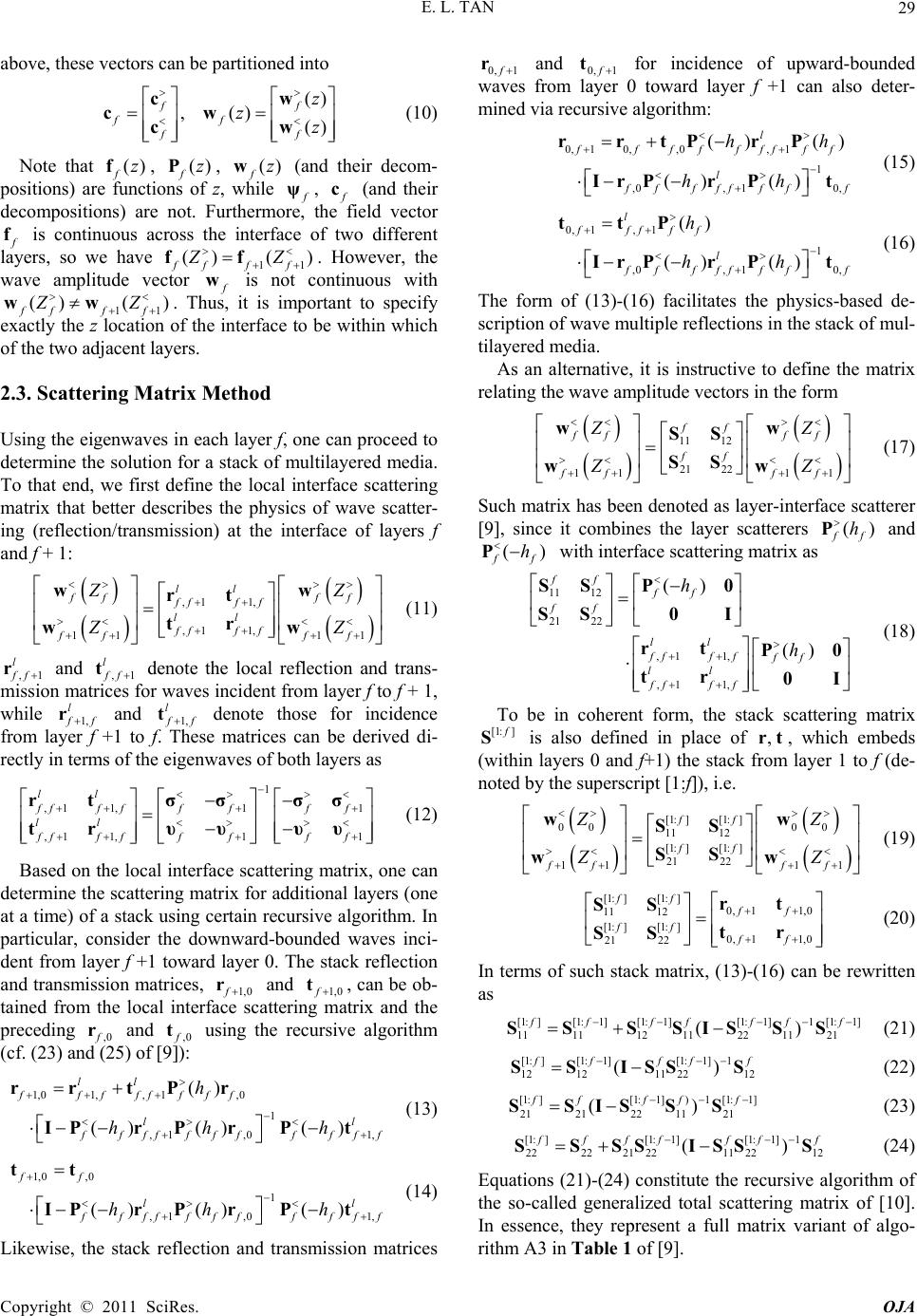 E. L. TAN Copyright © 2011 SciRes. OJA 29 above, these vectors can be partitioned into () ,() () ff ff ff z zz cw cw cw (10) Note that () fzf, () fzP, () fzw (and their decom- positions) are functions of z, while f ψ, f c (and their decompositions) are not. Furthermore, the field vector f f is continuous across the interface of two different layers, so we have 11 ()( ) fff f ZZ ff . However, the wave amplitude vector f w is not continuous with 11 ()( ) fff f ZZ ww . Thus, it is important to specify exactly the z location of the interface to be within which of the two adjacent layers. 2.3. Scattering Matrix Method Using the eigenwaves in each layer f, one can proceed to determine the solution for a stack of multilayered media. To that end, we first define the local interface scattering matrix that better describes the physics of wave scatter- ing (reflection/transmission) at the interface of layers f and f + 1: ,1 1, ,1 1, 11 11 ll ff ff fff f ll ffff ff ff ZZ ZZ ww rt tr ww (11) ,1 l f f r and ,1 l f f t denote the local reflection and trans- mission matrices for waves incident from layer f to f + 1, while 1, l f f r and 1, l f f t denote those for incidence from layer f +1 to f. These matrices can be derived di- rectly in terms of the eigenwaves of both layers as 1 ,1 1,11 ,1 1,11 ll fff fffff ll ffffffff rt σσ σσ tr υυ υυ (12) Based on the local interface scattering matrix, one can determine the scattering matrix for additional layers (one at a time) of a stack using certain recursive algorithm. In particular, consider the downward-bounded waves inci- dent from layer f +1 toward layer 0. The stack reflection and transmission matrices, 1, 0f r and 1, 0f t, can be ob- tained from the local interface scattering matrix and the preceding ,0 f r and ,0 f t using the recursive algorithm (cf. (23) and (25) of [9]): 1,01,, 1,0 1 ,1 ,01, () () ()() ll ffffffff ll f ffff ffffff h hh h rrtPr IPr PrPt (13) 1,0 ,0 1 ,1 ,01, () ()() ff ll f ffff ffffff hh h tt IPr PrPt (14) Likewise, the stack reflection and transmission matrices 0, 1 f r and 0, 1 f t for incidence of upward-bounded waves from layer 0 toward layer f +1 can also deter- mined via recursive algorithm: 0, 10,,0, 1 1 ,0, 10, () () () () l fffffffff l f ffffff f hh hh rrtP rP IrPr Pt (15) 0, 1, 1 1 ,0, 10, () () () l fffff l f ffffff f h hh ttP IrPr Pt (16) The form of (13)-(16) facilitates the physics-based de- scription of wave multiple reflections in the stack of mul- tilayered media. As an alternative, it is instructive to define the matrix relating the wave amplitude vectors in the form 11 12 21 22 11 11 ff ffff ff ff ff ZZ ZZ ww SS SS ww (17) Such matrix has been denoted as layer-interface scatterer [9], since it combines the layer scatterers () f f h P and () f f h P with interface scattering matrix as 11 12 21 22 ,1 1, ,1 1, () () ff ff ff ll fff fff ll fff f h h SS P0 SS 0I rt P0 tr 0I (18) To be in coherent form, the stack scattering matrix [1: ] f S is also defined in place of ,rt, which embeds (within layers 0 and f+1) the stack from layer 1 to f (de- noted by the superscript [1:f]), i.e. [1: ][1: ] 00 00 11 12 [1: ][1: ] 21 22 11 11 ff ff ff ff ZZ ZZ ww SS SS ww (19) [1: ][1: ] 0, 11,0 11 12 [1: ][1: ] 0, 11,0 21 22 ff ff ff ff rt SS tr SS (20) In terms of such stack matrix, (13)-(16) can be rewritten as [1:][1: 1][1: 1][1: 1]1[1: 1] 1111121122 11 21 () ff fffff SS SSISSS (21) [1: ][1:1][1:1]1 121211 2212 () f ffff SSISS S (22) [1:][1: 1])1[1: 1] 21 21 221121 () fffff SSISSS (23) [1: ][1:1][1:1]1 222221 22112212 () f fffff f SSSSISS S (24) Equations (21)-(24) constitute the recursive algorithm of the so-called generalized total scattering matrix of [10]. In essence, they represent a full matrix variant of algo- rithm A3 in Table 1 of [9]. 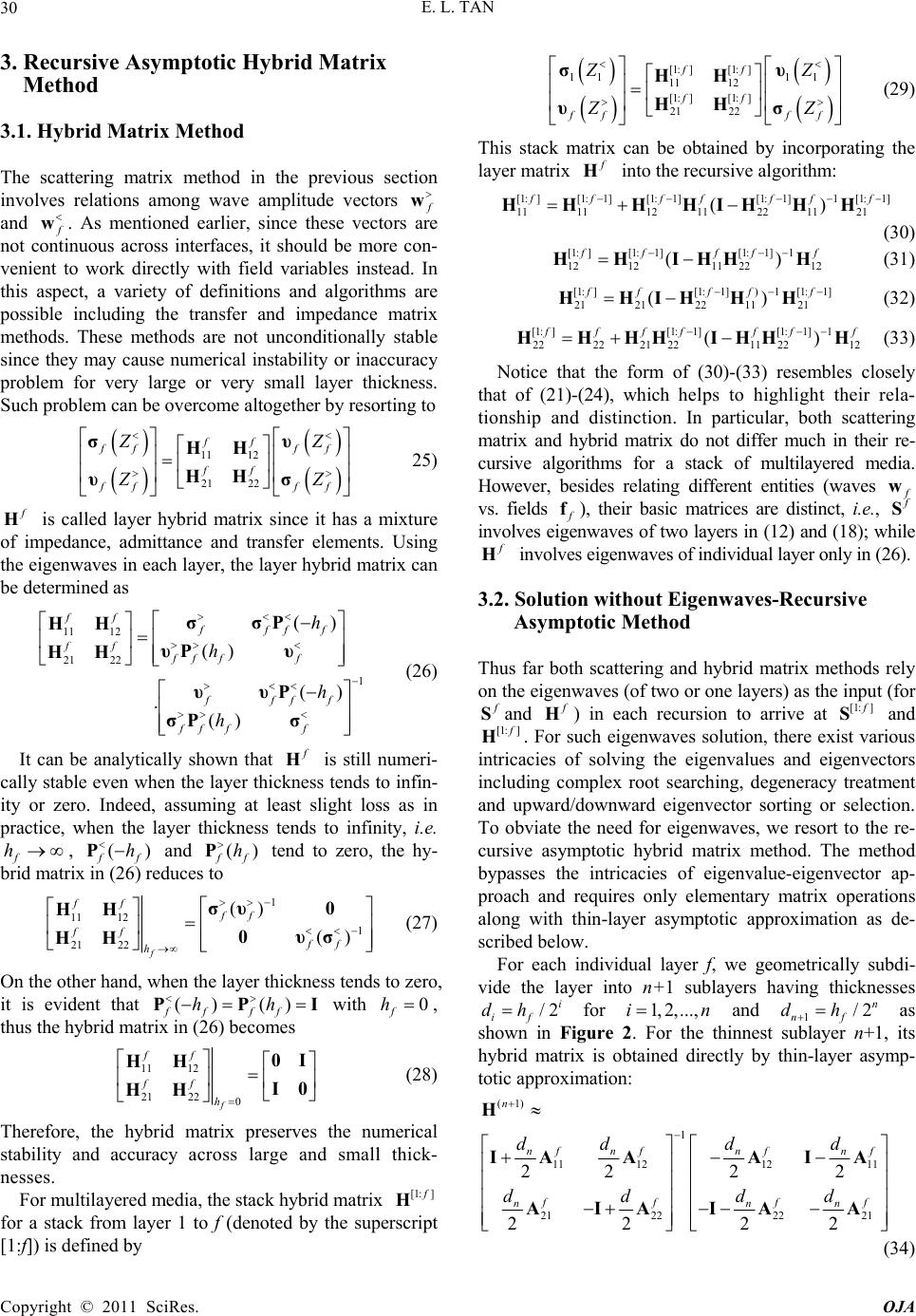 E. L. TAN Copyright © 2011 SciRes. OJA 30 3. Recursive Asymptotic Hybrid Matrix Method 3.1. Hybrid Matrix Method The scattering matrix method in the previous section involves relations among wave amplitude vectors f w and f w. As mentioned earlier, since these vectors are not continuous across interfaces, it should be more con- venient to work directly with field variables instead. In this aspect, a variety of definitions and algorithms are possible including the transfer and impedance matrix methods. These methods are not unconditionally stable since they may cause numerical instability or inaccuracy problem for very large or very small layer thickness. Such problem can be overcome altogether by resorting to 11 12 21 22 ff ff ff ff ff ff ZZ ZZ συ HH HH υσ 25) f H is called layer hybrid matrix since it has a mixture of impedance, admittance and transfer elements. Using the eigenwaves in each layer, the layer hybrid matrix can be determined as 11 12 21 22 1 () () () () ff ffff ff ff ff ffff ff ff h h h h σσP HH υPυ HH υυP σPσ (26) It can be analytically shown that f H is still numeri- cally stable even when the layer thickness tends to infin- ity or zero. Indeed, assuming at least slight loss as in practice, when the layer thickness tends to infinity, i.e. f h, () f f h P and () f f h P tend to zero, the hy- brid matrix in (26) reduces to 1 11 12 1 21 22 () () f ff ff ff ff h συ 0 HH 0υσ HH (27) On the other hand, when the layer thickness tends to zero, it is evident that () () ff ff hh PPI with 0 f h , thus the hybrid matrix in (26) becomes 11 12 21 220 f ff ff h 0I HH I0 HH (28) Therefore, the hybrid matrix preserves the numerical stability and accuracy across large and small thick- nesses. For multilayered media, the stack hybrid matrix [1: ] f H for a stack from layer 1 to f (denoted by the superscript [1:f]) is defined by [1: ][1: ] 11 11 11 12 [1: ][1: ] 21 22 ff ff ff ff ZZ ZZ συ HH HH υσ (29) This stack matrix can be obtained by incorporating the layer matrix f H into the recursive algorithm: [1:][1: 1][1: 1][1: 1]1[1: 1] 1111121122 11 21 () ff ff fff HH HHIHHH (30) [1: ][1:1][1:1]1 121211 2212 () f ffff HHIHH H (31) [1:][1: 1])1[1: 1] 212122 1121 () fffff HHIHHH (32) [1:][1: 1][1: 1] 1 222221 2211 2212 () f ffffff HHHHIHH H (33) Notice that the form of (30)-(33) resembles closely that of (21)-(24), which helps to highlight their rela- tionship and distinction. In particular, both scattering matrix and hybrid matrix do not differ much in their re- cursive algorithms for a stack of multilayered media. However, besides relating different entities (waves f w vs. fields f f), their basic matrices are distinct, i.e., f S involves eigenwaves of two layers in (12) and (18); while f H involves eigenwaves of individual layer only in (26). 3.2. Solution without Eigenwaves-Recursive Asymptotic Method Thus far both scattering and hybrid matrix methods rely on the eigenwaves (of two or one layers) as the input (for f Sand f H) in each recursion to arrive at [1: ] f S and [1: ] f H. For such eigenwaves solution, there exist various intricacies of solving the eigenvalues and eigenvectors including complex root searching, degeneracy treatment and upward/downward eigenvector sorting or selection. To obviate the need for eigenwaves, we resort to the re- cursive asymptotic hybrid matrix method. The method bypasses the intricacies of eigenvalue-eigenvector ap- proach and requires only elementary matrix operations along with thin-layer asymptotic approximation as de- scribed below. For each individual layer f, we geometrically subdi- vide the layer into n+1 sublayers having thicknesses /2 i if dh for 1, 2,...,in and 1/2 n nf dh as shown in Figure 2. For the thinnest sublayer n+1, its hybrid matrix is obtained directly by thin-layer asymp- totic approximation: (1) 1 11 121211 212222 21 222 2 22 22 n f fff nnn n ff ff nnn ddd d ddd d H IA AAIA AIA IAA (34) 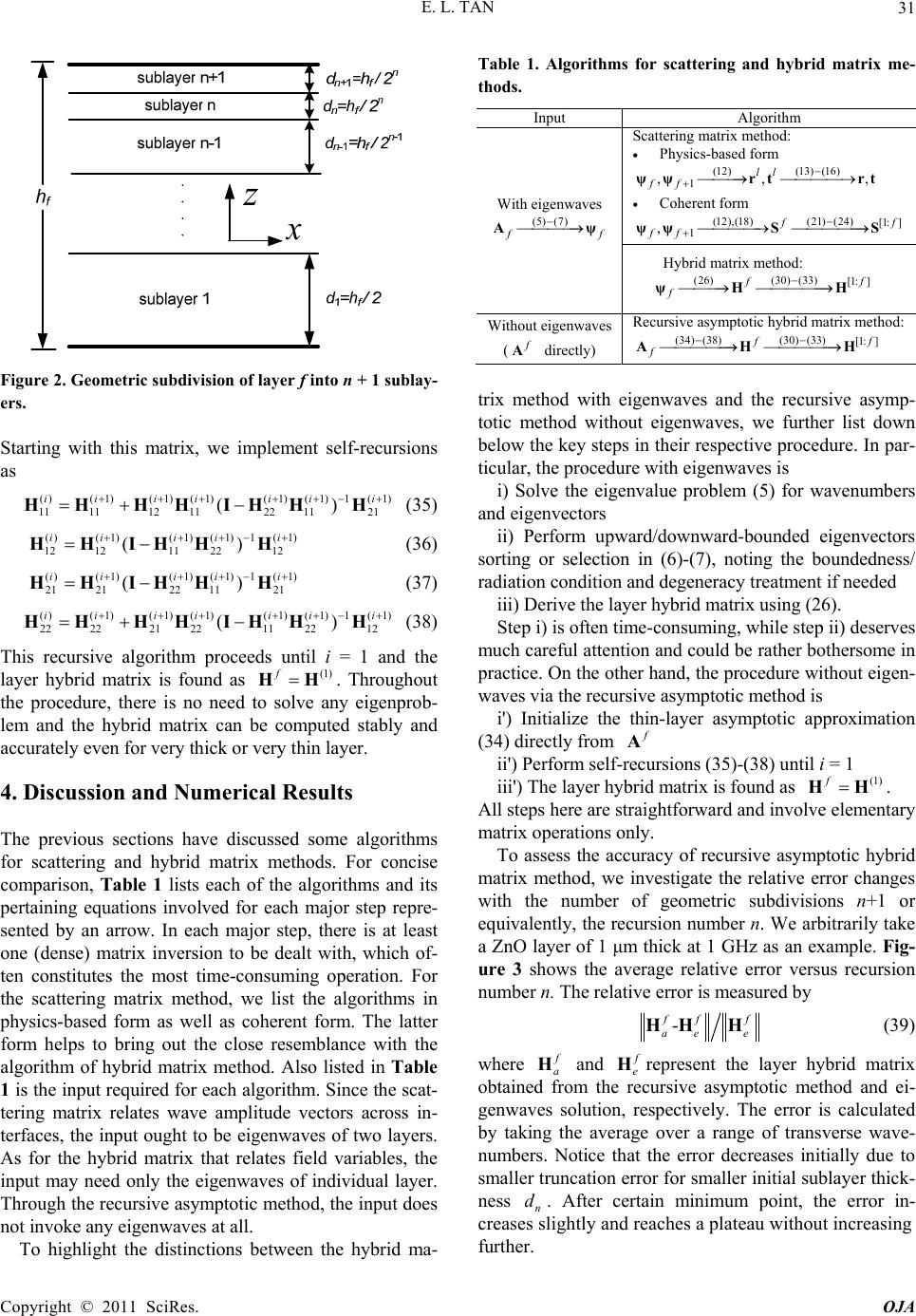 E. L. TAN Copyright © 2011 SciRes. OJA 31 x z Figure 2. Geometric subdivision of layer f into n + 1 sublay- ers. Starting with this matrix, we implement self-recursions as ()(1)(1)(1)(1)(1) 1(1) 1111121122 1121 () ii iiiii HH HHIHHH (35) ()(1)(1)(1) 1(1) 121211 2212 () iiii i HHIHH H (36) ()(1)(1)(1) 1(1) 212122 1121 () iiii i HHIHH H (37) ()(1)(1)(1)(1)(1) 1(1) 222221 22112212 () ii iiiii HH HHIHHH (38) This recursive algorithm proceeds until i = 1 and the layer hybrid matrix is found as (1)fHH. Throughout the procedure, there is no need to solve any eigenprob- lem and the hybrid matrix can be computed stably and accurately even for very thick or very thin layer. 4. Discussion and Numerical Results The previous sections have discussed some algorithms for scattering and hybrid matrix methods. For concise comparison, Table 1 lists each of the algorithms and its pertaining equations involved for each major step repre- sented by an arrow. In each major step, there is at least one (dense) matrix inversion to be dealt with, which of- ten constitutes the most time-consuming operation. For the scattering matrix method, we list the algorithms in physics-based form as well as coherent form. The latter form helps to bring out the close resemblance with the algorithm of hybrid matrix method. Also listed in Table 1 is the input required for each algorithm. Since the scat- tering matrix relates wave amplitude vectors across in- terfaces, the input ought to be eigenwaves of two layers. As for the hybrid matrix that relates field variables, the input may need only the eigenwaves of individual layer. Through the recursive asymptotic method, the input does not invoke any eigenwaves at all. To highlight the distinctions between the hybrid ma- Table 1. Algorithms for scattering and hybrid matrix me- thods. Input Algorithm Scattering matrix method: Physics-based form (12)(13) (16) 1 ,,, ll ff ψψrtrt Coherent form (12),(18)(21) (24)[1:] 1 , f f ff ψψ SS With eigenwaves (5) (7) f f Aψ Hybrid matrix method: (26)(30) (33)[1: ] f f f ψHH Without eigenwaves ( f A directly) Recursive asymptotic hybrid matrix method: (34) (38)(30) (33)[1:] f f f AHH trix method with eigenwaves and the recursive asymp- totic method without eigenwaves, we further list down below the key steps in their respective procedure. In par- ticular, the procedure with eigenwaves is i) Solve the eigenvalue problem (5) for wavenumbers and eigenvectors ii) Perform upward/downward-bounded eigenvectors sorting or selection in (6)-(7), noting the boundedness/ radiation condition and degeneracy treatment if needed iii) Derive the layer hybrid matrix using (26). Step i) is often time-consuming, while step ii) deserves much careful attention and could be rather bothersome in practice. On the other hand, the procedure without eigen- waves via the recursive asymptotic method is i') Initialize the thin-layer asymptotic approximation (34) directly from f A ii') Perform self-recursions (35)-(38) until i = 1 iii') The layer hybrid matrix is found as (1)f HH. All steps here are straightforward and involve elementary matrix operations only. To assess the accuracy of recursive asymptotic hybrid matrix method, we investigate the relative error changes with the number of geometric subdivisions n+1 or equivalently, the recursion number n. We arbitrarily take a ZnO layer of 1 μm thick at 1 GHz as an example. Fig- ure 3 shows the average relative error versus recursion number n. The relative error is measured by - ff f ae e HHH (39) where f a H and f e Hrepresent the layer hybrid matrix obtained from the recursive asymptotic method and ei- genwaves solution, respectively. The error is calculated by taking the average over a range of transverse wave- numbers. Notice that the error decreases initially due to smaller truncation error for smaller initial sublayer thick- ness n d. After certain minimum point, the error in- creases slightly and reaches a plateau without increasing further. 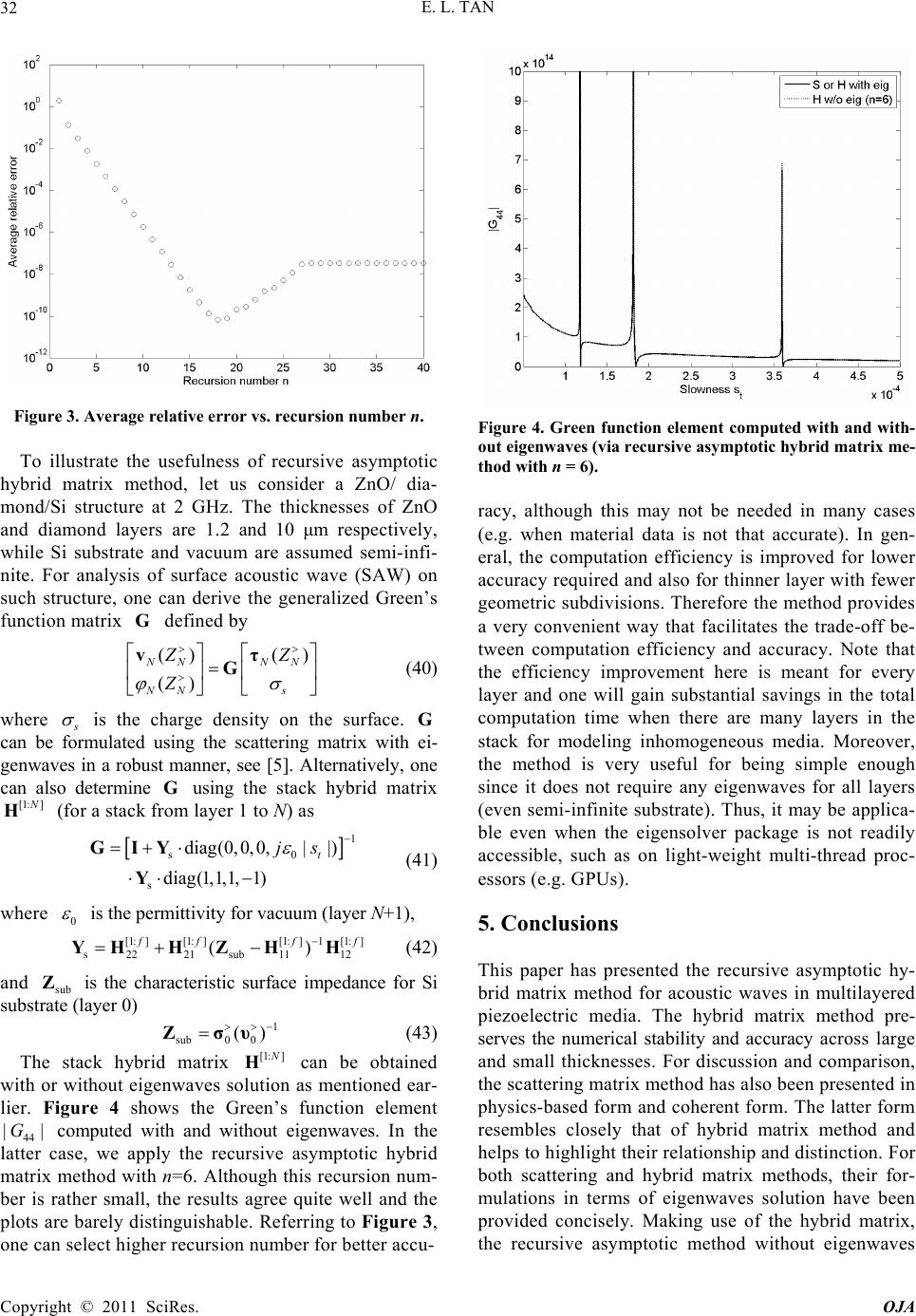 E. L. TAN Copyright © 2011 SciRes. OJA 32 Figure 3. Average relative error vs. recursion number n. To illustrate the usefulness of recursive asymptotic hybrid matrix method, let us consider a ZnO/ dia- mond/Si structure at 2 GHz. The thicknesses of ZnO and diamond layers are 1.2 and 10 μm respectively, while Si substrate and vacuum are assumed semi-infi- nite. For analysis of surface acoustic wave (SAW) on such structure, one can derive the generalized Green’s function matrix G defined by () () () NN NN NN s ZZ Z vτ G (40) where s is the charge density on the surface. G can be formulated using the scattering matrix with ei- genwaves in a robust manner, see [5]. Alternatively, one can also determine G using the stack hybrid matrix [1: ] N H (for a stack from layer 1 to N) as 1 s0 s diag(0,0,0,| |) diag(1,1,1, 1) t js GIY Y (41) where 0 is the permittivity for vacuum (layer N+1), [1: ][1: ][1: ]1[1: ] s2221 sub 1112 () f fff YHHZHH (42) and sub Z is the characteristic surface impedance for Si substrate (layer 0) 1 sub00 () Zσυ (43) The stack hybrid matrix [1: ] N H can be obtained with or without eigenwaves solution as mentioned ear- lier. Figure 4 shows the Green’s function element 44 ||G computed with and without eigenwaves. In the latter case, we apply the recursive asymptotic hybrid matrix method with n=6. Although this recursion num- ber is rather small, the results agree quite well and the plots are barely distinguishable. Referring to Figure 3, one can select higher recursion number for better accu- Figure 4. Green function element computed with and with- out eigenwaves (via recursive asymptotic hybrid matrix me- thod with n = 6). racy, although this may not be needed in many cases (e.g. when material data is not that accurate). In gen- eral, the computation efficiency is improved for lower accuracy required and also for thinner layer with fewer geometric subdivisions. Therefore the method provides a very convenient way that facilitates the trade-off be- tween computation efficiency and accuracy. Note that the efficiency improvement here is meant for every layer and one will gain substantial savings in the total computation time when there are many layers in the stack for modeling inhomogeneous media. Moreover, the method is very useful for being simple enough since it does not require any eigenwaves for all layers (even semi-infinite substrate). Thus, it may be applica- ble even when the eigensolver package is not readily accessible, such as on light-weight multi-thread proc- essors (e.g. GPUs). 5. Conclusions This paper has presented the recursive asymptotic hy- brid matrix method for acoustic waves in multilayered piezoelectric media. The hybrid matrix method pre- serves the numerical stability and accuracy across large and small thicknesses. For discussion and comparison, the scattering matrix method has also been presented in physics-based form and coherent form. The latter form resembles closely that of hybrid matrix method and helps to highlight their relationship and distinction. For both scattering and hybrid matrix methods, their for- mulations in terms of eigenwaves solution have been provided concisely. Making use of the hybrid matrix, the recursive asymptotic method without eigenwaves 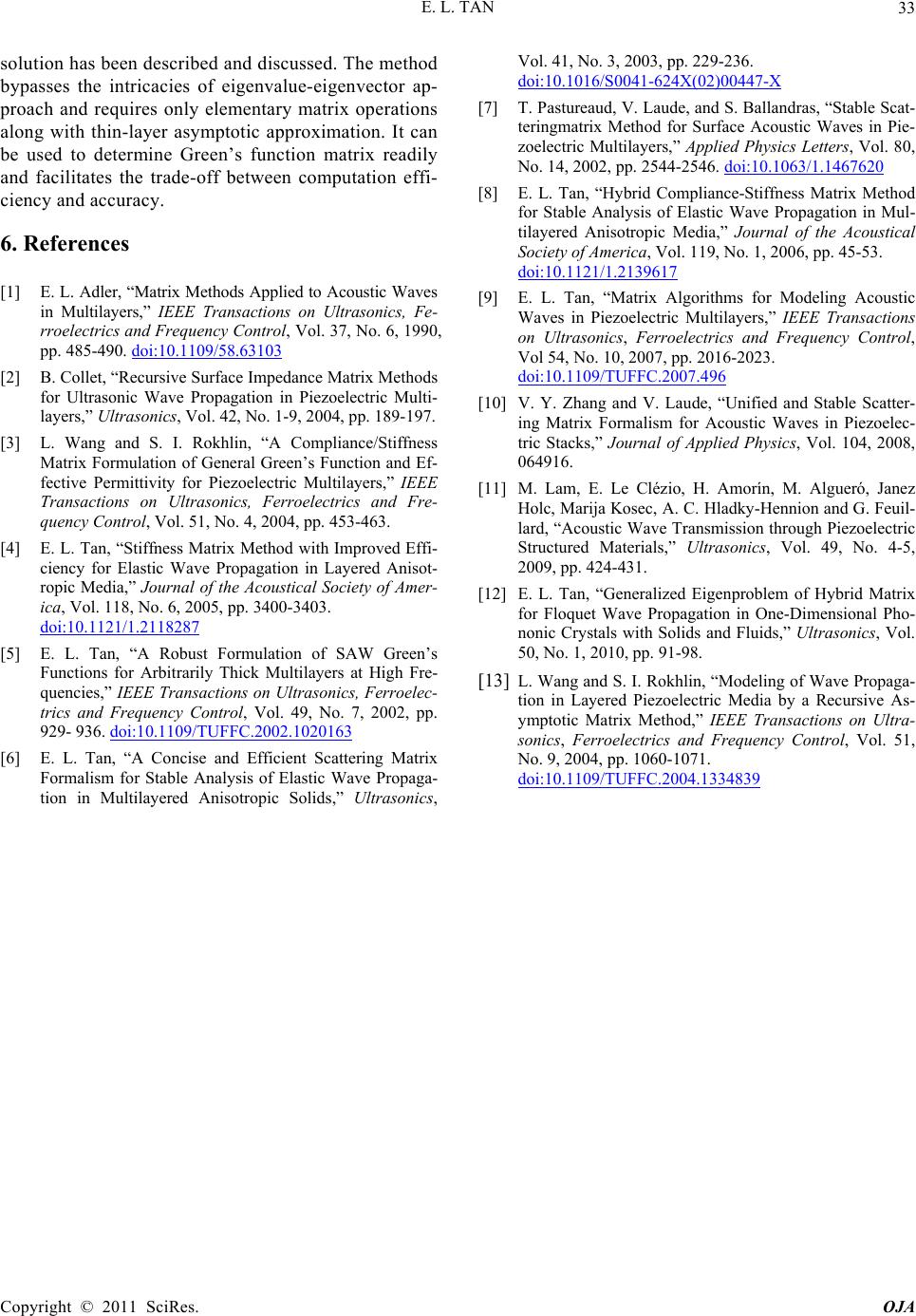 E. L. TAN Copyright © 2011 SciRes. OJA 33 solution has been described and discussed. The method bypasses the intricacies of eigenvalue-eigenvector ap- proach and requires only elementary matrix operations along with thin-layer asymptotic approximation. It can be used to determine Green’s function matrix readily and facilitates the trade-off between computation effi- ciency and accuracy. 6. References [1] E. L. Adler, “Matrix Methods Applied to Acoustic Waves in Multilayers,” IEEE Transactions on Ultrasonics, Fe- rroelectrics and Frequency Control, Vol. 37, No. 6, 1990, pp. 485-490. doi:10.1109/58.63103 [2] B. Collet, “Recursive Surface Impedance Matrix Methods for Ultrasonic Wave Propagation in Piezoelectric Multi- layers,” Ultrasonics, Vol. 42, No. 1-9, 2004, pp. 189-197. [3] L. Wang and S. I. Rokhlin, “A Compliance/Stiffness Matrix Formulation of General Green’s Function and Ef- fective Permittivity for Piezoelectric Multilayers,” IEEE Transactions on Ultrasonics, Ferroelectrics and Fre- quency Control, Vol. 51, No. 4, 2004, pp. 453-463. [4] E. L. Tan, “Stiffness Matrix Method with Improved Effi- ciency for Elastic Wave Propagation in Layered Anisot- ropic Media,” Journal of the Acoustical Society of Amer- ica, Vol. 118, No. 6, 2005, pp. 3400-3403. doi:10.1121/1.2118287 [5] E. L. Tan, “A Robust Formulation of SAW Green’s Functions for Arbitrarily Thick Multilayers at High Fre- quencies,” IEEE Transactions on Ultrasonics, Ferroelec- trics and Frequency Control, Vol. 49, No. 7, 2002, pp. 929- 936. doi:10.1109/TUFFC.2002.1020163 [6] E. L. Tan, “A Concise and Efficient Scattering Matrix Formalism for Stable Analysis of Elastic Wave Propaga- tion in Multilayered Anisotropic Solids,” Ultrasonics, Vol. 41, No. 3, 2003, pp. 229-236. doi:10.1016/S0041-624X(02)00447-X [7] T. Pastureaud, V. Laude, and S. Ballandras, “Stable Scat- teringmatrix Method for Surface Acoustic Waves in Pie- zoelectric Multilayers,” Applied Physics Letters, Vol. 80, No. 14, 2002, pp. 2544-2546. doi:10.1063/1.1467620 [8] E. L. Tan, “Hybrid Compliance-Stiffness Matrix Method for Stable Analysis of Elastic Wave Propagation in Mul- tilayered Anisotropic Media,” Journal of the Acoustical Society of America, Vol. 119, No. 1, 2006, pp. 45-53. doi:10.1121/1.2139617 [9] E. L. Tan, “Matrix Algorithms for Modeling Acoustic Waves in Piezoelectric Multilayers,” IEEE Transactions on Ultrasonics, Ferroelectrics and Frequency Control, Vol 54, No. 10, 2007, pp. 2016-2023. doi:10.1109/TUFFC.2007.496 [10] V. Y. Zhang and V. Laude, “Unified and Stable Scatter- ing Matrix Formalism for Acoustic Waves in Piezoelec- tric Stacks,” Journal of Applied Physics, Vol. 104, 2008, 064916. [11] M. Lam, E. Le Clézio, H. Amorín, M. Algueró, Janez Holc, Marija Kosec, A. C. Hladky-Hennion and G. Feuil- lard, “Acoustic Wave Transmission through Piezoelectric Structured Materials,” Ultrasonics, Vol. 49, No. 4-5, 2009, pp. 424-431. [12] E. L. Tan, “Generalized Eigenproblem of Hybrid Matrix for Floquet Wave Propagation in One-Dimensional Pho- nonic Crystals with Solids and Fluids,” Ultrasonics, Vol. 50, No. 1, 2010, pp. 91-98. [13] L. Wang and S. I. Rokhlin, “Modeling of Wave Propaga- tion in Layered Piezoelectric Media by a Recursive As- ymptotic Matrix Method,” IEEE Transactions on Ultra- sonics, Ferroelectrics and Frequency Control, Vol. 51, No. 9, 2004, pp. 1060-1071. doi:10.1109/TUFFC.2004.1334839 |

